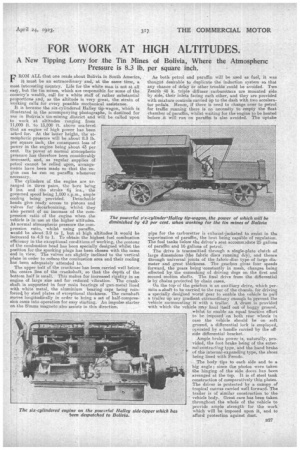FOR WORK AT HIGH ALTITUDES.
Page 25

If you've noticed an error in this article please click here to report it so we can fix it.
A New Tipping Lorry for the Tin Mines of Bolivia, Where the Atmospheric Pressure is 8.3 lb. per square inch.
-V ROM ALL that one reads about Bolivia in South America, ie must be an extraordinary and, at the same time, a most interesting country. Life for the white man is not at all easy, but the tin mines, which are responsible for some of the country's wealth, call for a white staff of rather imbetantiat proportion,s and, as the altitude is very great, the strain of working calls for every possible mechanical assistanee. It is because the six-eylindered Halley tip-wagon, -which is illustrated in the accompanying photographs, is destined for use in Bolivia's tin-mining district and will be called upon to work at altitudes ranging from 11,000 ft. to 15,800 ft. above sea-level that an engine of high power has been asked-for. At the latter height, the atmospheric pressure will be about 8.3 lb. per square inch, the consequent loss of power in the engine being about 43 per cent. Its power at normal atmospheric pressure has therefore been cousiderably inereased, and, as regular supplies of petrol cannot be relied upon, arrangements have been made so that the engine can be run on paraffin whenever necessary. The cylinders of the engine are arranged in three pairs, the bore being 5 ins, and the stroke 6i ins., the governed speed being 1,000 r.p.m., ample cooling being provided. Detachable heads give ready access to pistons and valves for decarbonizing, whilst they also permit of an increase of the compression ratio of the engine when the vehicle is in use at the higher altitudes. At. normal atmospheric pressure the compression ratio, w.hilst using paraffin, viculd be about 3.9 to 1, but at high altitudes it would be increased to 4.9 to 1. To obtain the highest fuel combustion efficiency in the exceptional conditions of working, the contour of the combustion head has been specially designed whilst the position for the sparking plugs has been chosen with the same end in view. The valves are slightly inclined to the vertical plane in order to reduce the combustion area and their cooling has been adequately attended to. The upper half of the crankcase has been carried well below. the centre line of the crankshaft, so thee the depth of the bottom half is small. This makes for increased rigidity in an engine cif large size and for reduced vibration. The crankshaft is supported in four main bearings of 'gun.nietali lined with white metal, the aluminium bearing caps being reinforced by steel plates of exceptional thickness. The camshaft moves longitudinally in order to bring a set of half-compression came into operation for easy starting. An impulse starter on the Simms magneto also assists in this direction. As both petrol and paraffin will be used as fuel, it was thought desirable to duplicate the induction system so that any chance of delay or other trouble could be avoided. Two Zenith 48 k. triple diffuser carburetters are mounted side by side, their inlets facing each other, and they are provided with mixture controls carried up to the dash with two accelerator pedals. Hence, if there is need to change over to petrol for traffic running there is no necessity to empty the float chamber of paraffin, whilst waiting for the engine to be heated before it will run on paraffin is also avoided. The uptake pipe for the carburetter is exhaust-jacketed to assist in the vaporization of paraffin, the heat being capable of repletion. The fuel tanks below the driver's seat aecommsdate 25 gallons of paraffin and 16 gallons of petrol. The drive is transmitted through a single-plate clutch of large dimensions (the fabric discs running dry), and thence through universal joints a the fabric-disc type of large diameter and great thickness. The gearbox gives four speeds forward, the gears being ',constantly in mesh, changes being effected by the enmeshing of driving dogs on the first and second motion shafts. The final drive from the differential is by chains protected by chain caseA. Ou the top of the gearbox is a.n auxiliary drive, which permits a shaft to be carried to the rear of the chassis, for driving a specially designed worn gear to enable the vehicle to pull a trailer up any gradient extraordinary enough to prevent the vehicle surmounting it with a trailer. A drum is provided with which the vehicle may haul itself out of boggy ground, .whilst to enable an equal tractive effort to be impOsed on both rear wheels in case the vehicle should be on soft ground, a differential lock is employed, operated by a handle carried by the off
side differential bracket. ..
Ample brake power is, naturally, provided, the foot brake being of the external-contracting type, and the hand brake of the internal-expanding type, the shoes being lined with Ferodo. The body tips to each side and to a big angle; since the photos were taken the hinging of the side doors has been arranged at the top. It is of steel tank construction of comparatively thin plates. The driver is protected by a canopy of tropical canvas carried well forward. The trailer is of similar construction to the ' vehicle body. Great care has been taken throughout the whole of the vehicle to provide ample strength for the -work which will be imposed upon it, and to afford protection against dust.






























